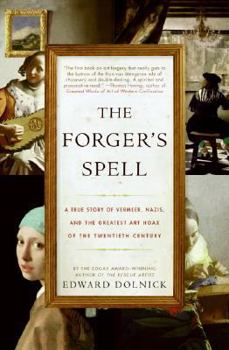The Forger's Spell: A True Story of Vermeer, Nazis, and the Greatest Art Hoax of the Twentieth Century
Select Format
Select Condition 
Book Overview
New York Times Bestseller"Dolnick brilliantly re-creates the circumstances that made possible one of the most audacious frauds of the 20th century. And in doing so Dolnick plumbs the nature of fraud... This description may be from another edition of this product.
Format:Hardcover
Language:English
ISBN:0060825413
ISBN13:9780060825416
Release Date:June 2008
Publisher:Harper
Length:368 Pages
Weight:1.10 lbs.
Dimensions:1.2" x 6.0" x 9.0"
Customer Reviews
6 ratings
Fine Art Afficionado Beware!
Published by Thriftbooks.com User , 5 years ago
This collection of 59 short chapters written in a concise, pithy and (sometimes) amusing style made me wonder if this was a series originally intended as installments for a periodical publication or blog. Still, it remains cohesive. The subject is intriguing. A testament to the power of greed, jealousy and revenge.
Excellent
Published by Thriftbooks.com User , 13 years ago
Great read, I'd have to say. Bought because I needed it for a class, and not being a big reader, I didn't realize how much of a good book it is. The seller was awesome. I asked for overnight and that's what I received. Also the book is in great condition, just as was stated on the listing. I fully recommend both this book and the seller. The Forger's Spell: A True Story of Vermeer, Nazis, and the Greatest Art Hoax of the Twentieth Century (P.S.)
A great story and an invitation to think about art
Published by Thriftbooks.com User , 13 years ago
Some themes -- What is in "The forger's spell"? * It's a fascinating story about interesting and entertaining characters, ones that you can hate and despise, as well as admire and root for. And, you will find yourself seduced into wanting to learn what they do and what will happen to them. Han Van Meegeren may have been a despicable cad, but he was also a entertaining one and a brilliant as well as a skilled craftsman. * It's an engaging meditation on value and valuation in art, on who sets values (in particular, monetary values) and how. You may become skeptical about the value of expensive works of art, or you may learn to appreciate them more, but you will certainly be encouraged to think through your own feelings about them. * And since it's a story of events and deeds, it encourages you to become an active participant in the formation of ideas and values about character and art. In fact, it's difficult *not* to be drawn into doing so. * It encourages you to do your own analysis of several works of art. You get guidance on how to evaluate these works of art, but that guidance is given almost in the form of an argument that encourages you to form your own values. * It's an account of another aspect of Europe in a time of war (WW II): history from the point of view of the looting of art, where those artistic treasures went, how (some of them) were found and recovered. * And, it's a series of lessons on the craft and technology of the forgery of painting. What must a forger do in order to succeed at producing a fake that deceives experts and art viewers? And, how does he produce that fake? In summary, "engaging" is the word that suggests the most about what I find in "The forger's spell". In engages me, and it pushes me and pulls me and motivates me to think through my own feelings and ideas and values about art.
Duping the Titans of Art
Published by Thriftbooks.com User , 14 years ago
This is the delightful, fascinating, and true story of how a little-known painter duped the titans of art. A David and Goliath tale that details how he did it - not once, but repeatedly - and suckered 30 million dollars out of the art world. In a light-hearted way, the author reveals and explores in detail the facets of human nature that allowed this to happen to sophisticated critics. It was all very logical and very human. As the story progresses, it is hard to avoid the feeling that the reader might have easily made the same mistakes. The story gives a good run-down on the art world, Nazi-occuppied Holland, and the rapacious art "collecting" by Hitler and Goering (one of those duped). It is a fun book, full of astounding suprises.
A Question of Attribution and Identity
Published by Thriftbooks.com User , 15 years ago
Han Van Meegeren was a mediocre artist with an enormous ego. Convinced that his talents were being maliciously ignored by the Dutch artistic community, he used considerable patience and ingenuity to develop a way of forging paintings by some of the greatest artists of Holland's Golden Age, especially those of Johannes Vermeer. His activities peaked during the Great Depression and the Nazi takeover of Holland during World War II, a time period when the Dutch were especially vulnerable as they looked for reminders of a more peaceful, prosperous, past. When I first opened this book I looked at the illustrations first. Comparing the Van Meegeren "art" with the real Vermeers completely confused me. If someone like me with no art training could spot the differences between sublime works like "Girl With A Pearl Earring" and travesties like "Christ at Emmaus," why on earth couldn't experts and cognoscenti do the same? Edward Dolnick does a good job of explaining the role preconceptions and prejudices play in evaluating a suspect painting and the way the milieu of the period affects judgement. Therefore, in the 1930s the Van Meegeren forgeries could pass muster because they displayed generally accepted views on beauty. Ten years later they were very obviously fakes because by then they looked out of date, which a true masterpiece could never do. I found Dolnick's discussions of the methods forgers use and the ways forgeries are detected the most interesting parts of this book. I disliked Van Meegeren at first, but he grew on me despite myself for the sheer brazenness of his gall and his obvious delight in fooling so many experts for so long. And it certainly didn't hurt that some of his most celebrated victims were among the nastiest and most horrible people of all time: Hitler and Goering and their ilk. I was very glad to know that while in prison Goering was told that he had been tricked into buying a Van Meejeren fake, and that that, at least, seemed to cause him real anguish in a way that his multitudinous crimes against humanity did not. Most importantly, this book causes its readers to ponder where the line between illusion and reality really lies at times.
An amazing story and a fascinating book!
Published by Thriftbooks.com User , 15 years ago
I loved this book. The story of how a brilliant conman, (who happened to be a terrible painter) fooled the world is astonishing, as gripping as a thriller. Dolnick is an expert storyteller, weaving back and forth between art history, World War II, forgery how-to lessons, and the tale of Van Meegeren. We meet Nazi villains like the clownish Goering; Vermeer, the mysterious and divinely talented master; blowhard "experts" and bigtime frauds. Dolnick is an expert explainer, but he's also funny and has a winning voice. There are novelistic touches throughout, and vivid scenes that will stay with you. The narrative zips along to a dramatic ending. If you like a good yarn, you'll really enjoy The Forger's Spell.
The Forger's Spell: A True Story of Vermeer, Nazis, and the Greatest Art Hoax of the Twentieth Century Mentions in Our Blog

Legendary Larceny
Published by Ashly Moore Sheldon • March 18, 2020
Thirty years ago, two men entered Boston's Isabella Gardner Museum in the wee hours of the morning. They left with thirteen works of art valued at more than $500 million. The case—the largest art robbery in US history—remains unsolved. Here we offer fascinating accounts of the world's most notorious heists.





